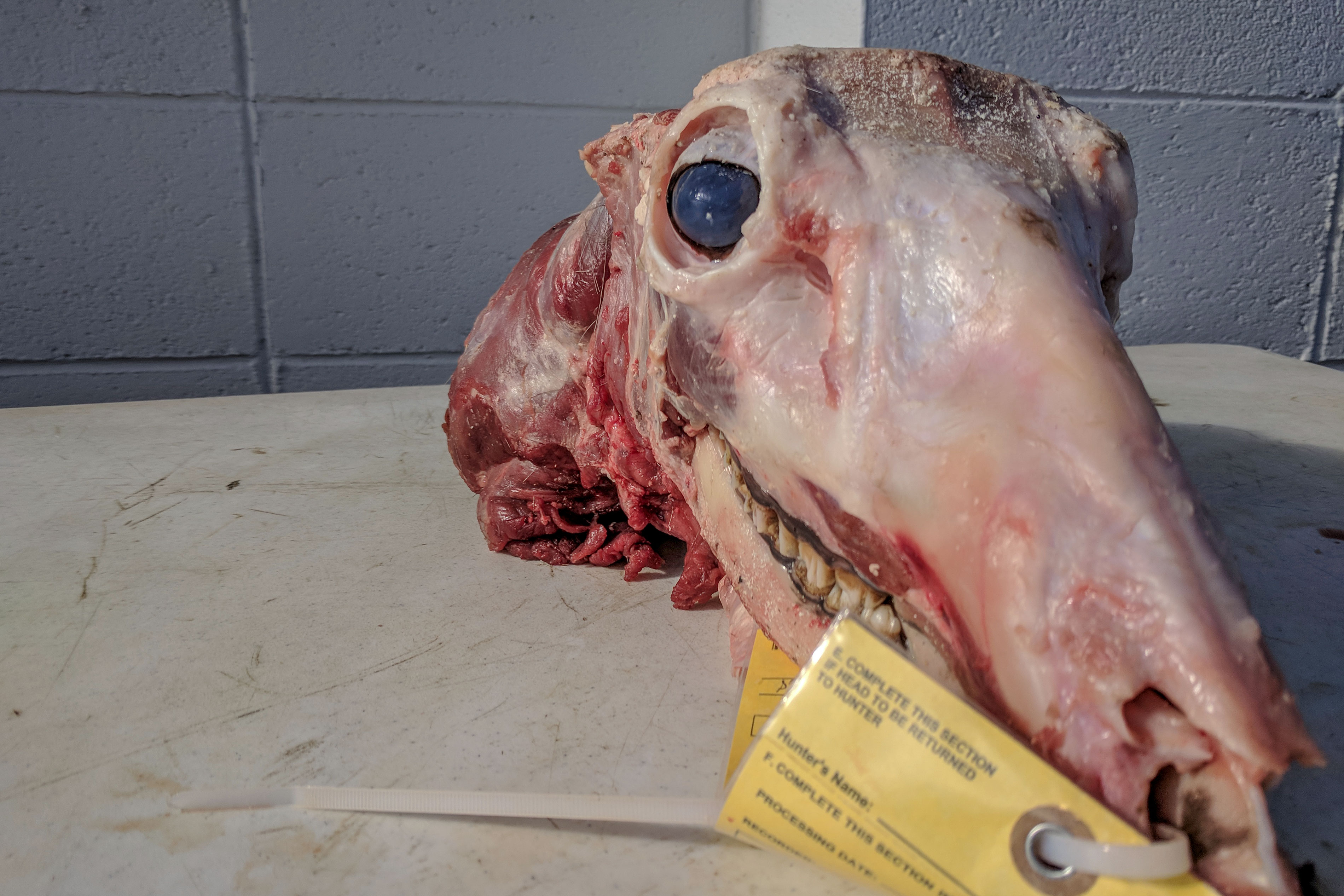Recent deaths from a rare brain disorder (CJD) in hunters who ate deer meat have sparked concerns about a possible jump from animals to humans.
"Zombie deer disease," also called chronic wasting disease (CWD), is spreading in wild animals, but scientists debate if it can cause a form of CJD in people.
CWD, a prion disease according to the CDC, affects wildlife like deer. Recent cases involve deer and moose in Canada, following outbreaks in Yellowstone National Park.
While no confirmed human cases exist, the deaths of two hunters who ate meat from CWD-infected deer raise new questions. Though doctors couldn't definitively link CWD to their CJD, they call for more research to see if the disease can jump species.
With CWD spreading in North America, Europe, and Asia, some scientists worry about the potential risk to humans. This concern stems from experiments, past cases of animal-to-human prion diseases (very rare), and the unknowns of climate change.
"No human cases from deer or elk have been documented," says a wildlife expert. "However, due to the unique nature of prions, health agencies prioritize keeping all prion diseases out of the food chain."
This is what we currently know about CWD and its potential link to humans.
Undead Deer: Understanding Chronic Wasting Disease (CWD)
Chronic Wasting Disease (CWD), also known as zombie deer disease, isn't your typical illness. It primarily targets deer, elk, moose, and other hoofed mammals (cervids) and spreads like a contagion, but forget about common germs like bacteria or viruses. The culprit behind this bizarre disease is a rogue protein called a prion.
Scientists are still unraveling the mystery of why prions go bad. Normally, these proteins play a role in cellular communication, but when they misfold, they turn into infectious agents that can corrupt healthy prions in the brain. This wreaks havoc on brain cells, leading to a cascade of neurological problems in infected animals.
Spotting a Zombie Deer: The Warning Signs
If you encounter a deer that seems like it stumbled out of a horror movie, it might be infected with CWD. These animals often exhibit dramatic weight loss despite excessive eating and drinking. Their balance goes wonky, leading to stumbling and difficulties getting around. Drooping ears and trouble swallowing are also telltale signs. The inability to swallow properly can lead to excessive drooling, which can tragically progress to pneumonia and death. It's this combination of emaciation, erratic movement, and vacant stares that gave rise to the nickname "zombie deer disease." However, these symptoms can take months or even years to develop, making detection through visual observation alone a challenge.
The Silent Spread of Prions
Misfolded prions don't just cause problems within an infected animal – they're also contagious. The disease can spread directly between animals through contact with bodily fluids or waste products. But even the environment can become a silent carrier. Prions can linger in soil, water, and food sources, creating a potential source of infection for unsuspecting animals. This lingering threat in the environment makes controlling the spread of CWD particularly difficult.
There's concern about chronic wasting disease (CWD) spreading from deer to humans, but the picture isn't entirely clear. While some regions see high infection rates in deer herds (like 23% in parts of Canada), there's no definitive proof that humans can contract CWD. Scientists are actively researching the possibility of animal-to-human transmission, though current evidence suggests it might not be a direct risk factor. This includes activities like consuming contaminated meat, interacting with infected animals, or even coming into contact with polluted soil or water.
To shed light on potential exposure, older studies looked at how often people eat wild game. A 2011 CDC survey found over 65% of participants reported eating wild game, highlighting the potential for contact with CWD. However, reassuringly, the study didn't find any evidence of CWD transmission to humans at that time.
In short, while CWD in deer is a cause for concern, the risk of it spreading to humans remains uncertain. Researchers are actively investigating this, and avoiding contact with potentially infected deer and deer products is a sensible precaution.
Here's a rephrased version of the text:
Prion dangers in humans
While prion diseases (also known as transmissible spongiform encephalopathies) affect both animals and humans, there are key differences between the two. In humans, these diseases include Creutzfeldt-Jakob Disease (CJD), which can be inherited, and variant CJD (vCJD).
vCJD, first identified in 1996, is caused by the same infectious agent responsible for "mad cow disease" (bovine spongiform encephalopathy or BSE) discovered in cattle a decade earlier. vCJD cases (around 230 globally) are linked to eating infected beef. This situation serves as a cautionary tale for chronic wasting disease (CWD) in deer and elk.
CWD and human risk: Uncertain but concerning
Although CWD and BSE are prion diseases, their structures differ. Scientists don't know for sure if CWD would cause similar illness in humans as vCJD did.
A study examining CJD cases in Colorado (where CWD was first found) and Wyoming (another CWD-affected state) between 1979 and 2000 yielded no clear link to CWD. The CJD incidence in these states mirrored the national average, and only two non-inherited cases linked to venison consumption were documented.
The takeaway: While the current evidence suggests a low risk of CWD transmission to humans, the possibility remains a concern due to the similarities with vCJD.
Creutzfeldt-Jakob disease (CJD) can be inherited, but it used to be spread through medical procedures as well. Thankfully, thanks to stricter sterilization practices implemented in the mid-1970s, this type of transmission no longer occurs (CDC).
While past studies haven't conclusively shown CJD jumping from animals to humans, recent research suggests it might be a possibility.
Chronic Wasting Disease (CWD) Transmission Studies: Mixed Results and Species Barriers
Body:
Lab-based and animal experiments investigating Chronic Wasting Disease (CWD) transmission yield mixed results, according to Dr. Mullinax. These variations depend on the species involved and the methods used for attempted transmission.
Studies suggest that each species possesses a unique level of resistance, or "barrier," to CWD prions. Interestingly, species more closely related to humans appear completely resistant to infection.
For instance, a 2018 National Institutes of Health study exposed 14 macaques (sharing about 93% genetic similarity with humans) to CWD-infected deer and elk brain matter. Over a decade of monitoring and tissue testing, researchers found no evidence of CWD transmission to the macaques.
However, other, potentially unpublished, experimental studies suggest a possibility of CWD transmission from cervids to macaques.
New Study Raises Concerns About Chronic Wasting Disease (CWD) Transmission to Humans
Researchers at the University of Calgary published a concerning study in 2022 that suggests Chronic Wasting Disease (CWD) might pose a greater risk to humans than previously thought. The study involved injecting prion isolates, the infectious agent responsible for CWD, from infected deer into specially bred mice. These mice, called transgenic mice, are genetically modified to express human prion protein, allowing scientists to study how human diseases might progress.
Over a period exceeding two and a half years, the mice exposed to CWD prions developed the disease themselves. Furthermore, the study detected the presence of infectious prions being excreted by the mice in their waste. This raises the possibility of fecal-oral transmission, which could complicate disease control efforts if CWD were to ever jump the species barrier to humans.
The atypical prion signature observed in the infected mice presents another cause for concern. The researchers theorize that if CWD can infect humans, the symptoms might differ from those observed in animals, potentially making diagnosis difficult.
However, it's important to note that this research, like many studies involving prion diseases, has limitations. As Dr. Osterholm points out, the current evidence isn't conclusive enough to definitively say whether CWD can definitively infect humans. More research is needed to solidify our understanding of the zoonotic potential of CWD.
Chronic Wasting Disease (CWD) Surveillance Efforts
This section details the ongoing efforts to monitor and understand Chronic Wasting Disease (CWD):
Expert Contingency Planning:
A team assembled by CIDRAP is actively assessing the potential risk of CWD transmission to humans and developing a response plan if needed.
Enhanced Surveillance:
Researchers at the University of Pennsylvania School of Veterinary Medicine's Wildlife Futures Program are analyzing the gut microbiota of deer to improve CWD detection methods and gain insights into the disease itself.
Additional Notes:
You can consider adding information about wildlife management agencies' surveillance programs that typically involve testing hunter-harvested animals.
Efforts to Understand and Mitigate Chronic Wasting Disease (CWD)
Researchers Race to Develop Live Tests and Prepare for Future Threats
This excerpt highlights several key areas of research concerning Chronic Wasting Disease (CWD).
Early Detection for Consumer Protection: A critical area of focus is the development of live tests for CWD by researchers from both academia and the United States Department of Agriculture (USDA). The ability to identify infected animals before they enter the food chain is essential to mitigating the potential for human exposure to CWD through contaminated deer meat.
Understanding Prion Mutation and Host Range: Experts raise concerns about the possibility of CWD prions, the infectious agents responsible for the disease, mutating over time. These mutations could potentially expand the range of animals susceptible to CWD, including humans. Research in this area is crucial to assess potential risks and inform public health recommendations.
Impact of Climate Change on CWD Transmission: The potential impact of climate change on deer populations is another factor being considered by researchers. Studies suggest that deer populations may increase in response to a changing climate. This could lead to a denser concentration of animals, which could in turn facilitate the spread of CWD among deer herds. Understanding how climate change might influence CWD transmission is vital for developing effective long-term management strategies.












0 Comments